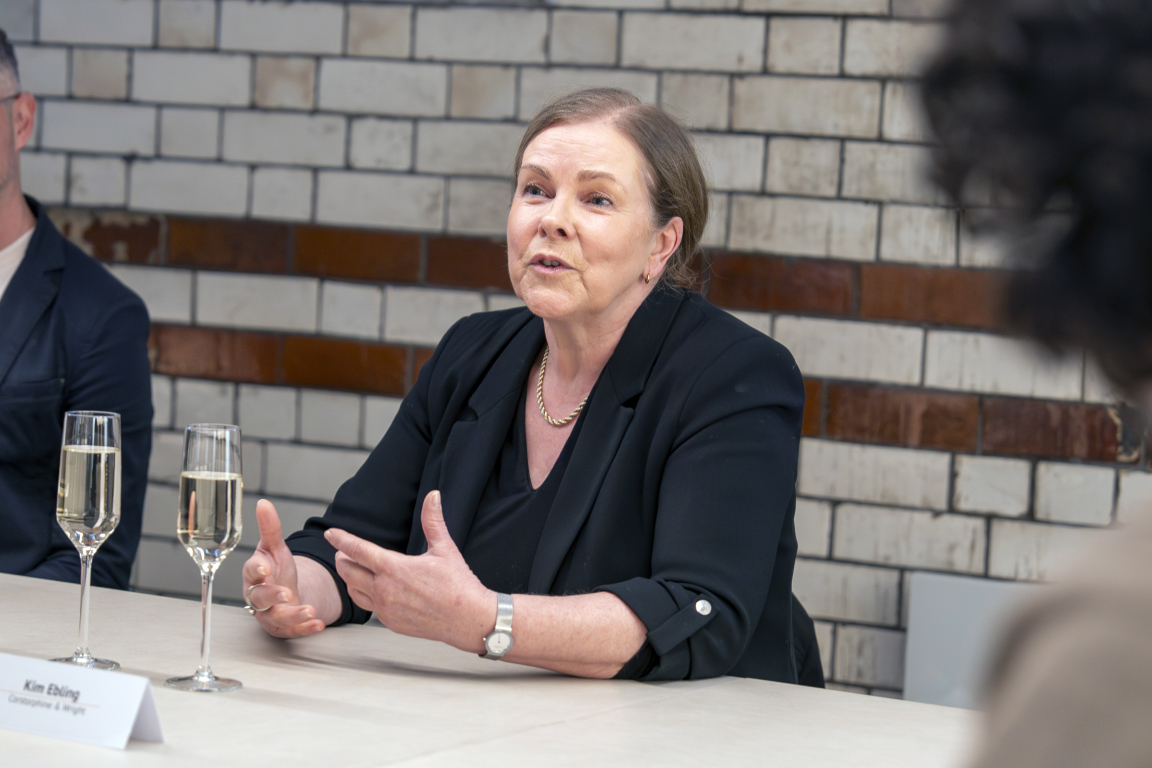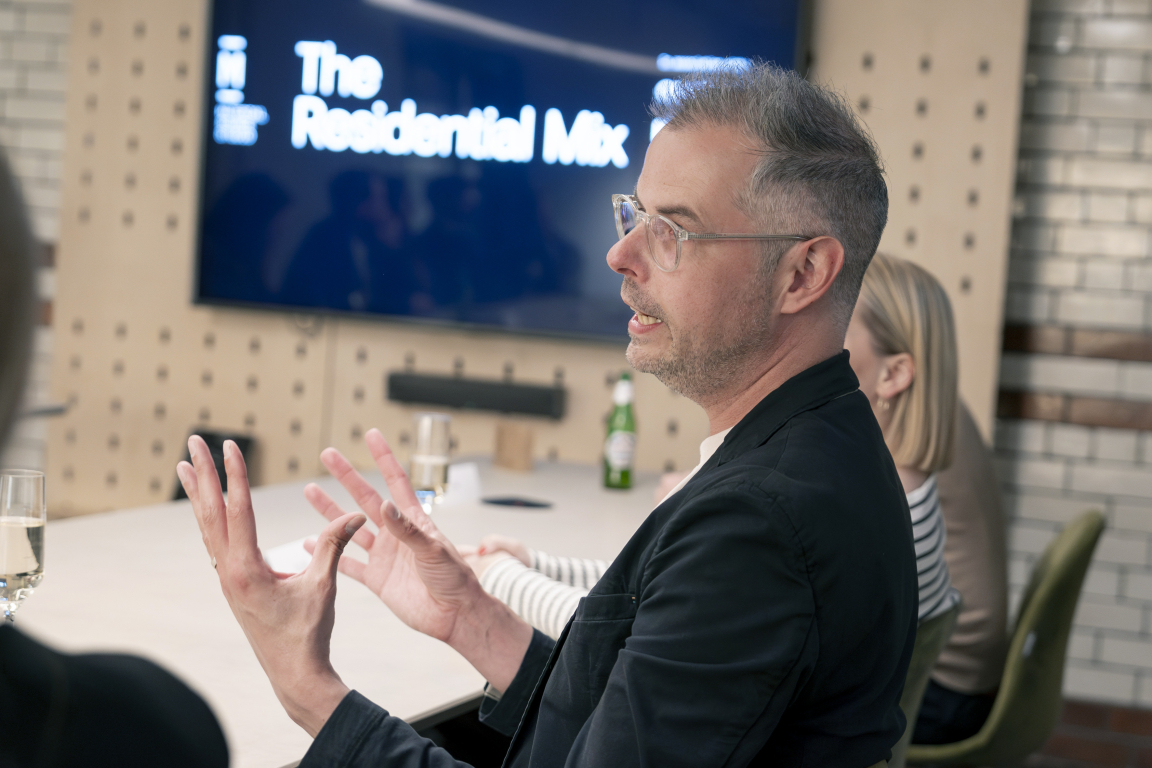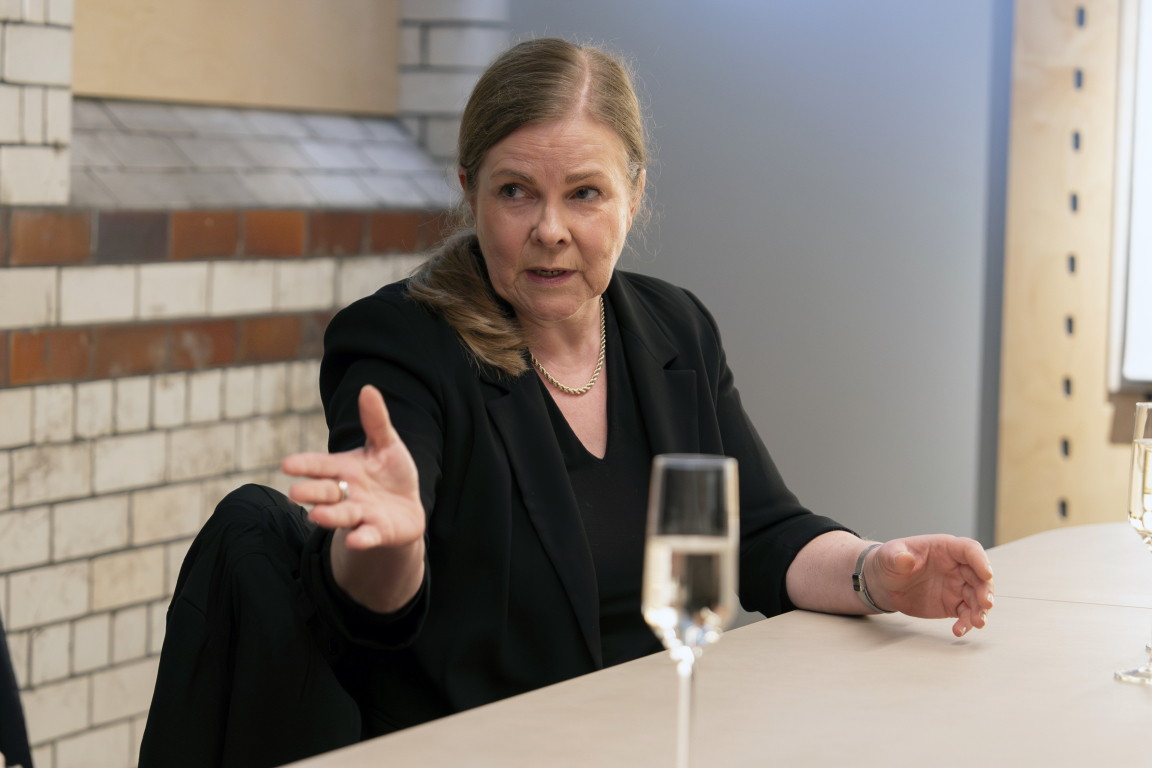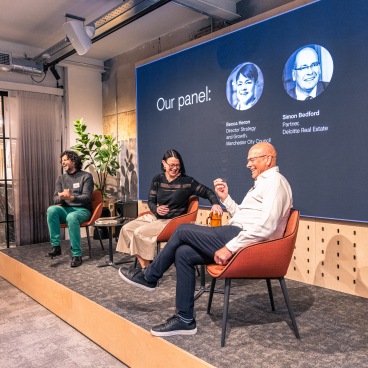Material Source Studio Asks: Has Manchester got its residential mix right?

Following our seminar on Manchester’s Property Outlook earlier this month, we hosted a roundtable discussion to keep the conversation going – specifically shining a spotlight on the city’s residential sector.
Though evidently a thriving UK city – Manchester’s residential mix has been criticised for not covering a balanced variation of asset class. Both our recent seminar panellists Becca Heron, director of strategy and growth, Manchester City Council, and Simon Bedford, partner, Deloitte, were keen to point out this is simply down to "growing pains" – not necessarily a negative thing, but something to be addressed as the city continues to sprawl.
Keen to dig deeper into how Manchester and other northern cities are faring in what is globally recognised as a complex property market, wrapped in uncertainty, and splintered with unknowns and what ifs, we brought together a group of sector professionals with a different set of perspectives to discuss themes including regeneration versus new build, affordable housing versus social, and PBSA versus BTR, with a dash of AI and smart tech, with chair, Material Source director, David Smalley.
Is the city moving in the right direction? And is it enabling people from all walks of life to move in? Read on to find out what our guests had to say…
Our guests

Lauren Robinson, interior designer, Ekho Studio

Ivor Phillips, director of architecture, Broadway Malyan

Lawrence Ferguson, associate and architect, Project Studio

Ellen Philcox, director, Euan Kellie

Georgie Fearnhead, senior creative designer, Amy Nicholas Interiors

Kim Ebling, director, Corstorphine & Wright

Ross Norbron, residential sales manager, Lutron Electronics

Sam Wheller, national manager of strategic accounts, Karndean

David Smalley, director, Material Source
Targets - Ambitious or aspirational?
Opening up the discussion, David mentioned the impending general election – the backdrop to any conversation around development and construction for the near future. At the recent UK REiiF event in Leeds, Labour’s deputy leader, Angela Rayner spoke on the urgent need for affordable homes. But with vast volume requirements - the current government estimates that 300,000 new homes are needed per year, and research by NHF and Crisis from Heriot-Watt University identified a need for 145,000 of these to be affordable – David asked, is it realistic?
Kim Ebling, director, Corstorphine & Wright, works predominantly in the social housing sector. She responded, “It takes a long time for anything to come to the point where the architect looks at it. It’s years in the making. Realistically, it’s not just about delivering new, but stabilising existing.
“If you look at the areas around Manchester, we have a lot of programmes going, especially with the decarbonisation funding, but it’s at the beginning of the journey rather than being a completed one. So again, success must be demonstrated before wider implementation. It’s challenging – we will rise to it – but by the time funding and sites are in place, we’re looking at years.”
Though ambitious, Ivor Phillips, director of architecture, Broadway Malyan, believes targets are necessary. “There is a lack of housing and that’s causing all sorts of problems, so we need targets. The homes that will be delivered in the next 5-years are already identified, we need to be looking much further ahead on 10/20/30 year time horizons.”
“With this in mind then, it provides a sense of the number of houses that could be built in the next 3-5 years – if we say 250,000 homes per year, are we anywhere close to that?” asked David.
“Even if we were”, responded Ivor, “the conversation needs to be about unlocking different types of houses – not just talking about city centre apartments, or housing estates built by PLC housebuilders – we need to focus on affordable homes, social housing, later living too. If we allow current homeowners to downsize into a decent size dwelling this will release a massive amount of housing stock for others to grow old into.”
Considering this conundrum from a planning perspective, Ellen Philcox, director, Euan Kellie, agreed on the importance of “clear targets at government level, that filters down to regional government plans, and then regional level”, stating that, “ultimately, developments come forward through strategic planning. This is the first thing we look at when clients come to us.”
Ultimately, developments come forward through strategic planning - Ellen Philcox, Euan Kellie


Strategy and stabilisation
Putting the spotlight on Manchester specifically, Ellen believes it’s in a “good place” in part due to Places for Everyone, an initiative which has spurred an up-to-date plan that “sets out strategic objectives for us as a region". “It’s a really positive springboard for us to move forward”, she commented.
At our recent Manchester Property Outlook seminar, panellists Becca Heron, Manchester City Council, and Simon Bedford, Deloitte, also indicated that Manchester has a very positive approach to planning, coined as “entrepreneurial” by Simon – a “do or die” response that emerged after the rapid decline of manufacturing.
Though Ellen went on to state that while the positives are many, the process is not without its challenges - “It’s target setting, but it’s also having the resource for those targets to be achieved. For example, if you submit an application in line with the development plan, the delivery aspect as to how quickly and efficiently it’s dealt with through the local planning authority needs consideration.”
The consensus from the room was that, though aspirational, the recommended target for new homes is hugely positive - it will lead to more development. “It’s a clear agenda point”, Ivor said. “And we’re still in a national housing crisis”, added Ellen.
“From a developer point of view, they’re interested in stability, so it has to be a good thing?”, suggested David.
Lawrence Ferguson, associate and architect, Project Studio, commented this is evident amongst clients. “We saw some clients ease off about a year ago due to concerns over where the market was going, but recently people seem more optimistic after the stabilisation of interest rates. And that’s then linked to the funds.”
In terms of available land for new development, the question as to how easy that is to acquire was posed. At the residential roundtable in Glasgow, it was highlighted as a potential roadblock. The guests in Manchester believe that brownfield sites and the reuse of land is a crucial aspect of meeting the new housing targets.
“I’m excited about the facilitation of regeneration”, said Ivor, “particularly on brownfield land.”
Here the topic of heritage was brought up by Georgie Fearnhead, senior creative designer, Amy Nicholas Interiors, and the risk of it being lost in Manchester. “Terrace houses are being wiped out, and it’s becoming a completely different city, so how do we keep hold of the heritage while providing new?”
Kim agreed, widening the conversation to her experiences in Liverpool, “Clearance doesn’t help with stabilisation. You start with regeneration. And we now have great new tools to look at how an area can be developed.”
“What tools are you referring to?” asked David. “AI”, answered Kim, “it’s a new toy and it’s exciting”, she added – a statement met with some nods from around the table, though not from all. More on that later…
Clearance doesn’t help with stabilisation. You start with regeneration - Kim Ebling, Corstorphine & Wright


Live, learn, work & play = BTR?
In each seminar and roundtable held on the topic of property this month, we’ve considered how our focus cities are doing when it comes to the ‘live, learn, work, play’ formula for success. David queried, “how well is Manchester doing with its mix? And how does this compare with other cities nearby such as Liverpool, which we’ve touched on, and Leeds?”
“In terms of housing delivery, Manchester has always overperformed”, answered Ellen, “it’s a place where people aspire to live and work in. When you compare it to other cities in the north, I think Manchester is market leading in driving the different types of development.”
Ivor agreed, “It’s a good example of how development can be delivered and is enabled and supported by the local authorities through policy, planning and engagement with the council. The argument as to how high rises have impacted on the development of heritage assets exists, alongside affordable housing” – all points raised at the recent Property Outlook seminar and acknowledged by Becca Heron, director of strategy and growth at the Council as being areas for the city to work on.
Ekho Studio is a practice known for its BTR projects, and Lauren Robinson, an interior designer there, commented on the popularity of this particular asset class in the city, saying, “We’re finding the position of where these developments sit is also important. As an example, we’re working on a scheme in Trafford currently and the city hasn’t been brought out as far as that yet, so there’s the ‘live’ side of things, then there’s the ‘play’. So we’re having to consider more of that within the space itself, normally with a small budget and footplate to cover areas for work, socialising, exercise…all of these things.”
Ross Norbron, residential sales manager, Lutron Electronics, highlighted client Moda Living – largely considered a sector trailblazer in BTR in Manchester, “Moda led the way when it comes to amenities.”
Continuing on the topic of BTR, Lawrence added, “They are a lot of fun to design these spaces, but they are exclusive – they’re not open to the public. The amenities are therefore incredible for the people that live there, but that’s it.
All of this live, work, play is going on – behind closed doors - Lawrence Ferguson, Project Studio
“When you consider this mix then, as you’ve pointed out, the part that often isn’t right is residential. We’re talking about Manchester here, but looking at Glasgow, they have a very low city centre population. How is Liverpool doing? Or Leeds?”
“Interestingly, Manchester as a city centre was never meant for residential”, answered Kim, whose professional background began with mill conversions in Ancoats, before moving over to Liverpool. “If you compare the two 25-years ago, Liverpool was like a rocket taking off. We had learn, work, play and we had the residential. Manchester didn’t have that, and it took an awful lot of time to change. So doctors’ surgeries and schools – nothing was here.”
Kim believes the turning point was a less than warm reception to 'towers' in Liverpool, the very thing that Manchester adopted. “One thing was a catalyst for another. It was a pivotal moment.”


Addressing unbalance – co living
For a city to thrive, it must seemingly offer a balanced mixture of asset class – something Manchester has been called into question for. Keen to get our guests’ views, David asked, “how is the city doing when it comes to offering residential in different asset classes?”
One area where its full growth potential has not yet been uncovered, according to Georgie, is luxury homes for high-net-worth individuals – “there is an opportunity to commercialise this”, she suggests. Something which Ross agrees with. Though this sector has not been immune to the challenges felt on a wider scale, he adds. From rising interest rates to supply issues.
This level of commercialisation is something Lauren feels has been reached in the BTR sector, “there’s structure in place now”, she said. But on the topic of supply, some of the clients she has worked with buy in early and hold stock to ensure current rates.
“So what about co living?” asked David. “It’s coming”, came the response from the room.
“We’ve submitted an application for a co living scheme in Birmingham”, commented Ivor in reference to an energy positive development proposed for Gas Street – the first street in Birmingham city centre to have public street lighting, so this new building would be another first of its kind in the city too, for energy positivity. “The co living concept itself was not an easy one to sell to the council” Ivor adds, “we did a lot of work around this.”
“Would you want to live in one?”, Lawrence asked the room. A mixed response came in reply.
Ellen believes the best way for co living to contribute positively to the residential mix is by including some “PBSA, some co living, and some apartments – so people can transition through them. There is flexibility for them to be rented for different periods of time, and as work has changed, this could appeal to Gen Z who might not want to commit to a city for too much time at once. It’s plugging the gap.”
Lawrence, on the other hand, thinks it’s a “bizarre journey to take people on”, and more than anything, just costs too much.
The affordability of taking the next step after university to living in an apartment is getting further and further away - Lauren Robinson, Ekho Studio
Playing devil’s advocate when it comes to the subject of cost, Ellen commented, “Manchester as a city needs to be aspirational, and actually, there are a lot of people here who can afford to live in these developments. We want to attract people that are highly skilled.”
From a density perspective – highlighted as an integral element to cultivating a vibrant city in our Glasgow Property Outlook seminar, Ivor suggests co living is also a way of getting "more units into less space.”
Sam Wheller, national manager of strategic accounts, Karndean, also flagged the flexibility of tenure for development owners, “these apartments can be leased for a week, a month – Monday-Friday – you can be creative in the way they are let.”
“This doesn’t create a community though”, responded Lauren.
“Only time will tell as to how popular these schemes are”, suggested Ivor. Yet Kim reminded us that co living is no new thing – “30-years ago, it was already in place – it’s just been rebranded.”


High spec, high expectations - PBSA
Moving the conversation to PBSA – student accommodation – David asked, “how’s that world?”
“It’s the same requirements as BTR”, answered Lawrence, “perhaps with a slightly reduced spec – but not always.”
Communal space and amenity is feeding into a PBSA scheme Ivor is working on in Salford for a new operator brand.
And this is the same for Ekho Studio's PBSA projects in Manchester and Leeds, particularly, said Lauren, “the same spec, amenities, and design that’s perhaps louder and brighter for the next generation.”
“Why the higher spec?” asked Ross. “The influence of social media”, Lauren believes.
“Is the formula for PBSA right, then?” David queried.
“Students coming out of university have a level of unsustainable debt”, answered Ivor, “and it doesn’t seem to be letting up. The levels are being driven up by the increase in offer and amenity” – “and expectation”, added David. “And a lot of this probably is social media driven”, Ivor agreed.
“If the investors think there’s a market though”, said David, “they will continue.”
“What about university halls then?”, pondered Georgie, “how can universities compete?”
Ivor suggested that universities have a strong influence when it comes to planning. And Ellen highlighted the fact that attracting international students is key for these universities, so a certain level of accommodation is needed to support that. Ellen also believes there are plans to move students into the city centre, to free up some of the Victorian terraces around Fallowfield to retain families hoping to stay.

Affordable – is it doable?
Putting the focus on affordable, David mentioned the current requirement for affordable housing needing to be 20% of a new residential scheme – “is this working?” he asked the group.
The response illustrated that perhaps more clarity is needed around both the policy itself and the meaning of affordable.
“That’s actually not the policy”, replied Ellen, “it’s ‘20% of housing across the city needs to be affordable’ – but the way it’s interpreted is that it’s 20% of each development.”
On this point, Kim added, “Affordable means being on the same platform, and 20% of a development being affordable means the specs change, so it’s not equalising what the offer should have been.” An example of this being done in practice she highlighted as a development in Salford, which is 100% affordable. “We matched city centre living but with an affordable price tag. And then you look at the developments around us and they literally have the same view.”
Though here, Ellen stressed the importance of differentiating between developers – there is an element of risk versus profit and although it may seem from the outset that all commercial development organisations make vast swaths of income, it’s often not the case – sometimes just 10-15% profit.


War games
Returning to the topic of innovation by way of looking forward, David asked “who deals with AI, and will it make a difference? Can it solve the problems in residential?”
Picking up where she left off, Kim replied, “It won’t solve the problem, but it is a great tool for looking at regeneration. It’s a bit like ‘war games’ – we’re playing scenarios out. It’s a good way of showing how not to do it before doing it. It helps with timescales and investment potential.” This is particularly useful in the public sector, she said, where you’re “playing with other peoples’ money.”
I don’t think AI will overtake architects, but it does help on the technical side, especially on high rise - Kim Ebling, Corstorphine & Wright
Expanding on the topic of technology in the residential sector, David asked whether this notion of ‘smart’ plays a big role in enhancing developments?
“It’s not just for the people that previously could afford it”, said Georgie, “but people expect it – from controlling lights to music.”
This is the same for amenity spaces added Lawrence, as being seen as an “extension of home” – technology was said to be the “starting point for the design of amenity space in high rise towers" – it’s personalisation at the touch of a button, due to apartments becoming smaller.
Ross suggests this also helps with the scene setting of a building, with Lutron supplying products to many of the high rise developments in Manchester’s city centre, giving the ‘wow’ factor to potential tenants.
The final point came on the topic of sustainability, with Ellen stating that perhaps policy in terms of residential is “chasing the tail of what the market wants.”
“Young people want to know what the performance of a building is – things like embedded carbon – now spoken about much more widely day-to-day.”
“And when it comes to products, people want better for longer and that has to be a good thing generally then, doesn’t it?” asked David.
“Yes, it’s driving the younger generations”, answered Kim. “And it’s driving better specs”, said Lawrence.


This brought the conversation to a close – for now. But if you’ve not already done so, you can read the write-ups from our Manchester Property Outlook seminar here, and our Glasgow Property Outlook seminar here, plus our roundtable on The Residential Mix in Glasgow here. Stay tuned for more property-related content on the site over the coming weeks as we move towards a Housing focus in August.
Huge thanks to all our roundtable guests, and to our supporters for the evening, Lutron and Karndean – both partners at Material Source Studio.
All image credits: Noah Da Costa






